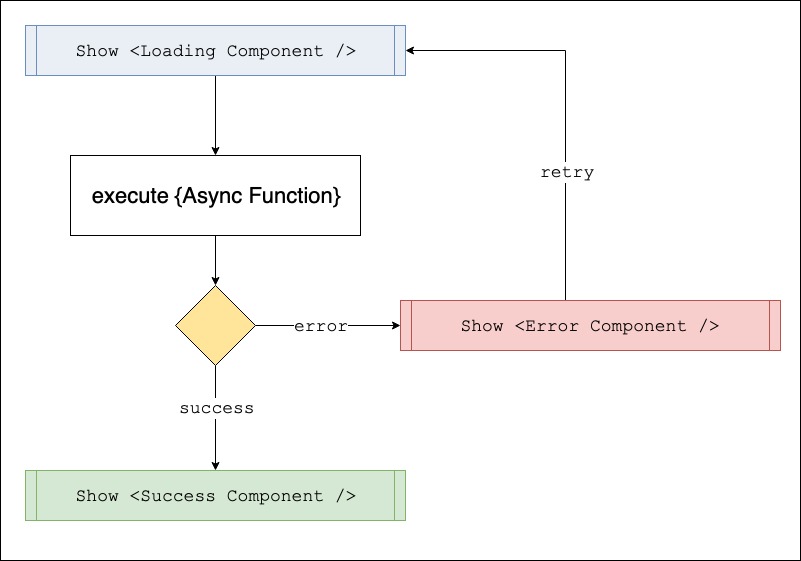Handling loading, error, and success callback of promise out of the box!
“The best products don’t focus on features, they focus on clarity.” — Jon Bolt
Showing loading state, error, and success callback is common in any application.
In ES6, there's a Promise that do some async function. Lot of redundant code being used to show the loading before the async function executed, and show error / success state when async function is done.
This library will handle before and after execution of async function by separate the load in another place.
using npm:
npm install @traveloka/rps --save
using yarn:
yarn add @traveloka/rps
Brief usage:
- With decorator
import React from 'react';
import { withPageStateProvider, pageState } from '@traveloka/rps';
import {
PageLoading,
PageError,
SnackbarSuccess,
} from 'project/ui';
const config = {
page: {
fullLoading: PageLoading,
fullError: PageError,
},
snackbar: {
successType: SnackbarSucces,
}
};
@withPageStateProvider(config)
@pageState()
export default class UserListPage extends React.Component {
@pageState({
loading: 'page.fullLoading',
error: 'page.fullError',
success: 'snackbar.successType'
})
componentDidMount() {
return fetchUserList();
}
}- Without decorator
import React from 'react';
import { withPageStateProvider, pageState } from '@traveloka/rps';
import {
PageLoading,
PageError,
SnackbarSuccess,
decorate,
} from 'project/ui';
import compose from 'lodash/fp/compose'; // https://hackernoon.com/function-composition-with-lodash-d30eb50153d1
const config = {
page: {
fullLoading: PageLoading,
fullError: PageError,
},
snackbar: {
successType: SnackbarSucces,
}
};
class UserListPage extends React.Component {
componentDidMount() {
return fetchUserList();
}
}
decorate(UserListPage, {
componentDidMount: pageState({
loading: 'page.fullLoading',
error: 'page.fullError',
success: 'snackbar.successType'
}),
})
export default compose(
withPageStateProvider(config),
pageState(),
)(UserListPage);There are 3 core States: loading, error and success. Each State have it's own order of execution and additional props.
NOTE! React Class Component must be wrapped with
pageStateHOC to be able using HOC in Class Method.
State is being used in @pageState decorator in class method. It is used to show such event in according order. ex: you want to show Full Loading Page, before function being executed, you should use loading State.
Structure:
@withPageStateComponent({
[path]: [StateComponent] // declaration of all available path
})
@pageState({
[state]: [path] // state must be one of [loading, error, success]
})
componentDidMount() {
// ...
}loadinghave order before async function is executed.
Additional Props:
| Property | Type | Default Value | Description |
|---|---|---|---|
cancel |
func |
To cancel the function execution. NOTE! Still on experiment. |
errorhave order after async function is executed.errorwill be execute, if the async function throw an error exception.
Additional Props:
| Property | Type | Default Value | Description |
|---|---|---|---|
error |
object |
An error object that being throw in async function | |
retry |
func |
Function that would execute async function. Function that being executed will have same parameter as before. |
successhave order after async function is executed.successwill be execute, if the async function not throw an error exception.
Additional Props:
| Property | Type | Default Value | Description |
|---|---|---|---|
result |
any | Value that being resolve by async function. |
See in COMPONENTS
withPageStateProvider(stateConfig)
withPageStateProvider HOC is a shortcut to wrap the React Component with PageStateProvider.
Structure of stateConfig:
{
[path: string]: [StateComponent: ReactElement]
}Example:
{
pageLoading: (props) => <div>Loading...</div>,
pageError: (props) => <div>Error...</div>
snackbar: { // path could be nested object.
success: (props) => <SnackbarAutoClose type="success" message={props.result} />, // to use, path should be "snackbar.success"
error: (props) => <SnackbarAutoClose type="error" action={props.retry} />
}
}pageState HOC is being used in React Class Component and Class Method.
pageStateas HOC in React Class Component, is a shortcut to wrap the React Component withPageStateConsumer.pageStateas HOC in Class Method, this trigger the state to being show before / after the method being executed.pageState(config).config, there are 2 structures that could being pass in config.- Basic.
structure:
example:
@pageState({ [state: "loading"|"error"|"success"]: [path: string] })
@pageState({ loading: 'page.loading' })
- Customizeable, giving flexibility to pass additional property to state component.
structure:
example:
@pageState({ [state: "loading"|"error"|"success"]: { path: [path: string], payload: [additional_property: object] } })
@pageState({ loading: { path: 'page.fullLoading', payload: { title: 'Waiting...' } } })
- Basic.
structure:
yarn
yarn bootstrapcd examples/apps
yarn start
react-native run-ios # open another terminalcd examples/web
yarn startTo pass additional property to StateComponent, in pageState HOC in Class Method, you must pass payload object.
Example:
// Loading.js
export default function Loading({title}) {
return (<div>{title}</div>)
}
// ----------
// Container.js
import {
withPageStateProvider,
pageState
} from '@traveloka/rps';
import Loading from './Loading';
@withPageStateProvider({
loading: Loading
})
@pageState()
export default class Container extends React.Component {
@pageState({
path: 'loading',
payload: {
title: 'Please wait...',
}
})
componentDidMount() {
//...
}
}Using ES.next decorators is optional. This section explains how to use them, or how to avoid them.
Advantages of using decorators:
- Minimizes boilerplate, declarative.
- Easy to use and read. A majority of the MobX users use them.
Disadvantages of using decorators:
- Stage-2 ES.next feature
- Requires a little setup and transpilation, only supported with Babel / Typescript transpilation so far
You can approach using decorators in two ways:
- Enable the currently experimental decorator syntax in your compiler (read on)
- Don't enable decorator syntax, but leverage the built-in utility decorate to apply decorators to your classes / objects.
Using decorator syntax:
import { withPageStateProvider, pageState } from '@traveloka/rps';
@withPageStateProvider()
@pageState()
class Timer extends React.Component {
@pageState({ loading: 'modal.loading' })
componentDidMount() {
/* ... */
}
render() {
/* ... */
}
}Using the decorate utility:
import compose from 'lodash/fp/compose';
import {
withPageStateProvider,
pageState,
decorate
} from '@traveloka/rps';
class Timer extends React.Component {
componentDidMount() {
/* ... */
}
render() {
/* ... */
}
}
// decorate method
decorate(Timer, {
componentDidMount: pageState({ loading: 'modal.loading' }),
});
export default compose(
withPageStateProvider(),
pageState()
)(Timer);To enable support for decorators, follow the following steps. Install support for decorators: npm i --save-dev babel-plugin-transform-decorators-legacy. And enable it in your .babelrc file:
{
"presets": [
"es2015",
"stage-1"
],
"plugins": ["transform-decorators-legacy"]
}
Note that the order of plugins is important: transform-decorators-legacy should be listed first. Having issues with the babel setup? Check this issue first.
For babel 7, see issue 1352 for an example setup.
See CONTRIBUTING.md

